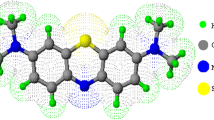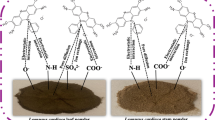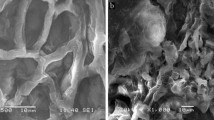Abstract
In the present study, the biosorption of Astrazon Blue FGRL (AB) which is one of the cationic dyes most commonly used in nylon and acrylic textiles from aqueous solution was studied onto tea waste (tea dust discharged after using), a waste lignocellulosic material. The effects of different parameters including biosorbent dosage, initial pH, contact time, initial dye concentration, and temperature were studied. Tea waste was characterized by Brunauer-Emmett-Teller (BET) surface area, FTIR, and SEM. The experimental equilibrium data were fitted to the Langmuir and Freundlich isotherms. The Freundlich isotherm model fitted to the experimental data better than the Langmuir isotherm. The maximum biosorption capacity, q max, was found to be 263.16 mg/g. The experimental data were discussed in detail comparing with some other low-cost adsorbents reported for AB removal in the previous literature, considering q max, adsorbent surface area, experimental conditions, isotherm models, and thermodynamics of the AB adsorption. The thermodynamic data indicated that AB biosorption was feasible but nonspontaneous, endothermic, and a chemisorption reaction.
Access this chapter
Tax calculation will be finalised at checkout
Purchases are for personal use only
Similar content being viewed by others
References
Jia Z, Li Z, Ni T, Li S (2017) Adsorption of low-cost absorption materials based on biomass (Cortaderia selloana flower spikes) for dye removal: kinetics, isotherms and thermodynamic studies. J Mol Liq 229:285–292
Pagnanelli F, Mainelli S, Veglio F, Toro L (2003) Heavy metal removal by olive pomace: biosorbent characterization and equilibrium modeling. Chem Eng Sci 58:4709–4717
Eren E, Afsin B (2007) Investigation of a basic dye adsorption from aqueous solution onto raw and pre-treated sepiolite surfaces. Dyes Pigments 73:162–167
Hong J-M, Lin B, Jiang J-S, Chen B-Y, Chang C-T (2014) Synthesis of pore-expanded mesoporous materials using waste quartz sand and the adsorption effects of methylene blue. J Ind Eng Chem 20:3667–3671
Marungrueng K, Pavasant P (2006) Removal of basic dye (Astrazon Blue FGRL) using macroalga Caulerpa lentillifera. J Environ Manag 78:268–274
Farah JY, El-Gendy N, Farahat LA (2007) Biosorption of Astrazone Blue basic dye from an aqueous solution using dried biomass of Baker’s yeast. J Hazard Mater 148:402–408
Karagözoglu B, Tasdemir M, Demirbas E, Kobya M (2007) The adsorption of basic dye (Astrazon Blue FGRL) from aqueous solutions onto sepiolite, fly ash and apricot shell activated carbon: kinetic and equilibrium studies. J Hazard Mater 147:297–306
Punjongharn P, Meevasana K, Pavasant P (2008) Influence of particle size and salinity on adsorption of basic dyes by agricultural waste: dried Seagrape (Caulerpa lentillifera). J Environ Sci 20:760–768
Ongen A, Ozcan HK, Elmaslar Ozbas E, Balkaya N (2012) Adsorption of Astrazon Blue FGRL onto sepiolite from aqueous solutions. Desalin Water Treat 40:129–136
Langmuir I (1918) The adsorption of gases on plane surfaces of glass, mica and platinum. J Am Chem Soc 40:1361–1403
Freundlich HMF (1906) Über die adsorption in lösungen. Z Phys Chem 57:385–470
Culp RL, Wesner GM, Culp GL (1978) Handbook of advanced wastewater treatment. Van Nostrand Reinholds Company, New York
Johnson TA, Jain N, Joshi HC, Prasad S (2008) Agricultural and agro-processing wastes as low cost adsorbents for metal removal from wastewater: a review. J Sci Ind Res 67:647–658
Vien-Lin D, Colthup NB, Fateley WG, Grasselli JC (1991) The handbook of infrared and raman characteristic frequencies of organic molecules. Academic Press, San Diego
Fazal A, Rafique U (2012) Acid/base treated spent black tea characterization of functional groups and lead sorptive mechanism. Int J Chem Environ Eng 3:217–224
Kapoor A, Viraraghavan T (1997) Heavy metal biosorption sites in Aspergillus niger. Bioresour Technol 61:221–227
Malkoc E, Nuhoglu Y (2006) Removal of Ni(II) ions from aqueous solutions using waste of tea factory: adsorption on a fixed-bed column. J Hazard Mater B135:328–336
Uddin MT, Islam MA, Mahmud S, Rukanuzzaman M (2009) Adsorptive removal of methylene blue by tea waste. J Hazard Mater 164:53–60
Auta M, Hameed BH (2011) Preparation of waste tea activated carbon using potassium acetate as an activating agent for adsorption of Acid Blue 25 dye. Chem Eng J 171:502–509
Malkoc E, Nuhoglu Y (2006b) Fixed bed studies for the sorption of chromium(VI) onto tea factory waste. Chem Eng Sci 61:4363–4372
Yang X, Cui X (2013) Adsorption characteristics of Pb(II) on alkali treated tea residue. Water Res Ind 3:1–10
Jiang Z, Xie J, Jiang D, Yan Z, Jing J, Liu D (2014) Enhanced adsorption of hydroxyl contained/anionic dyes on nonfunctionalized Ni@SiO2 core-shell nanoparticles: kinetic and thermodynamic profile. Appl Surf Sci 292:301–310
Malekbala MR, Hosseini S, Yazdi SK, Soltani SM, Malekbala MR (2012) The study of the potential capability of sugar beet pulp on the removal efficiency of two cationic dyes. Chem Eng Res Design 90(5):704–712
Sánchez-Martín J, González-Velasco M, Beltrán-Heredia J, Gragera-Carvajal J, Salguero-Fernández J (2010) Novel tannin-based adsorbent in removing cationic dye (methylene blue) from aqueous solution: kinetics and equilibrium studies. J Hazard Mater 174:9–16
Baek MH, Ijagbemi CO, Se-Jin O, Kim DS (2010) Removal of malachite green from aqueous solution using degreased coffee bean. J Hazard Mater 176:820–828
Giahi M, Rakhshaee R, Bagherinia MA (2011) Removal of methylene blue by tea wastages from the synthesis waste waters. Chinese Chem Letters 22:225–228
Kumar KV, Sivanesan S, Ramamurthi V (2005) Adsorption of malachite green onto Pithophora sp., a fresh water algae: equilibrium and kinetic modeling. Process Biochem 40:2865–2872
Liu MH, Huang JH (2006) Removal and recovery of cationic dyes from aqueous solutions using spherical sulfonic lignin adsorbent. J Appl Polym Sci 101:2284–2291
Chen H, Zhao J, Dai G, Wu J, Yan H (2010) Adsorption characteristics of Pb(II) from aqueous solution onto a natural biosorbent, fallen Cinnamomum camphora leaves. Desalination 262:174–182
Nasuha N, Hameed BH, Mohd Din AT (2010) Rejected tea as a potential low-cost adsorbent for the removal of methylene blue. J Hazard Mater 175:126–132
Dhodapkar R, Rao NN, Pande SP, Kaul SN (2006) Removal of basic dyes from aqueous medium using a novel polymer: Jalshakti. Bioresour Technol 97:877–885
Rubin E, Rodriguez P, Herrero R, Cremades J, Barbara I, Sastre de Vicente ME (2005) Removal of methylene blue from aqueous solutions using as biosorbent Sargassum muticum: an invasive macroalga in Europe. J Chem Technol Biotechnol 80:291–298
Cay S, Uyanık A, Ozaşık A (2004) Single and binary component adsorption on copper (II) and cadmium (II) from aqueous solution using tea industry waste. Sep Purif Technol 38:273–280
Sharma P, Kaur R, Baskar C, Chung W-J (2010) Removal of methylene blue from aqueous waste using rice husk and rice husk ash. Desalination 259:249–257
El Ashtoukhy ESZ (2009) Loofa egyptiaca as a novel adsorbent for removal of direct blue dye from aqueous solution. J Environ Manag 90:2755–2761
Li K, Zheng Z, Huang X, Zhao G, Feng J, Zhang J (2009) Equilibrium, kinetic and thermodynamic studies on the adsorption of 2-nitroaniline onto activated carbon prepared from cotton stalk fibre. J Hazard Mater 166:213–220
Gueu S, Yao B, Adouby K, Ado G (2007) Kinetics and thermodynamics study of lead adsorption on to activated carbons from coconut and seed hull of the palm tree. Int J Environ Sci Technol 4:11–17
Yazdani M, Mahmoodi NM, Arami M, Bahrami H (2012) Surfactant-modified feldspar: isotherm, kinetic, and thermodynamic of binary system dye removal. J Appl Polym Sci 126:340–349
Nasuha N, Hameed BH (2011) Adsorption of methylene blue from aqueous solution onto NaOH-modified rejected tea. Chem Eng J 166:783–786
Eren E (2009) Investigation of a basic dye removal from aqueous solution onto chemically modified Unye bentonite. J Hazard Mater 166:88–93
Amarasinghe BMWPK, Williams AR (2007) Tea waste as a low cost adsorbent for the removal of Cu and Pb from wastewater. Chem Eng J 132:299–309
Kavitha D, Namasivayam C (2008) Capacity of activated carbon in the removal of acid brilliant blue: determination of equilibrium and kinetic model parameters. Chem Eng J 139:453–461
Acknowledgments
This research was supported by the Research Project Unit at Istanbul University (Project No: BYP–5090).
Author information
Authors and Affiliations
Corresponding author
Editor information
Editors and Affiliations
Rights and permissions
Copyright information
© 2019 Springer International Publishing AG, part of Springer Nature
About this chapter
Cite this chapter
Balkaya, N. (2019). Biosorption of Dye from Aqueous Solutions by a Waste Lignocellulosic Material. In: Balkaya, N., Guneysu, S. (eds) Recycling and Reuse Approaches for Better Sustainability. Environmental Science and Engineering(). Springer, Cham. https://doi.org/10.1007/978-3-319-95888-0_23
Download citation
DOI: https://doi.org/10.1007/978-3-319-95888-0_23
Published:
Publisher Name: Springer, Cham
Print ISBN: 978-3-319-95887-3
Online ISBN: 978-3-319-95888-0
eBook Packages: Earth and Environmental ScienceEarth and Environmental Science (R0)




